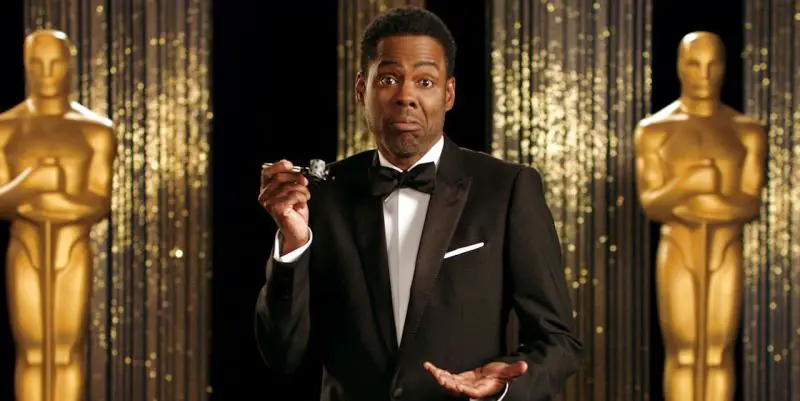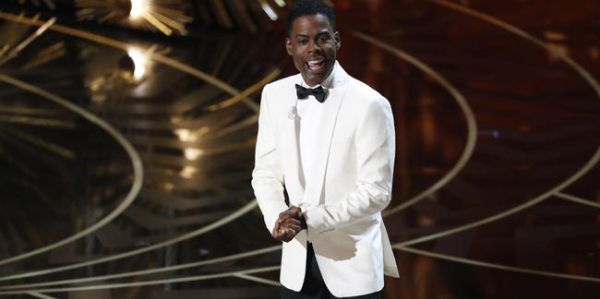The 2016 Oscars & Chris Rock’s Unidimensional Equality: A Female Filmmaker’s Perspective

Laurie Agard studied Psychology and Writing in graduate school after…
The membership of the Academy of Motion Picture Arts and Sciences is 94 percent white. Equally real and shameful is the fact that 94 percent of top-grossing films in this country are directed by men. In addition to shameful, the words real, facts, and equally are important here.
Thanks in part to a black female filmmaker, Jada Pinkett Smith, who was the first to call for a boycott of the 2016 Oscars for its lack of diversity, Chris Rock had the world’s attention for a program of change the night of February 28. With millions of dollars and unlimited creative resources at his disposal, his central platform could easily have been, “When storytellers in Hollywood are not as diverse as the world around us, individuals and society are harmed.”
Instead, Rock began his monologue sexualizing and diminishing two successful female artists. “Jada boycotting the Oscars is like me boycotting Rihanna’s panties. I wasn’t invited. Oh, that’s not an invitation I would turn down.”
Silencing and tearing down women is part of the Old Boy Network. But isn’t that what Chris Rock was railing against?
The Hollywood Sorority
“Hollywood is sorority racist. It’s like, ‘We like you, Rhonda. But you’re not a Kappa.’ That’s how Hollywood is.”
He had months to prepare his speech. Why would he choose the word “sorority?” Less than than seven percent of the top grossing 250 films in the past decade have been directed by women. A dozen women, not all of whom are white, is hardly enough to form a sorority. And if Hollywood was run by a sorority, would it really be churning out the types of movies it’s churning out now?
“Another big thing tonight – somebody told me this – you’re not allowed to ask women what they’re wearing anymore. There’s this whole thing, ‘Ask her more. You have to ask her more.’ You know it’s like, ‘You ask the men more.’ Hey, everything’s not sexism, everything’s not racism. They ask the men more because the men are all wearing the same outfits, okay? Every guy in here is wearing the exact same thing. You know if George Clooney showed up with a lime green tux on, and a swan coming out his ass, somebody would go, ‘Whatcha wearing George?”
Let’s pause for a moment because this is important.

Part of the magic of both live TV and jokes is they allow storytellers to pull the rug out from under the audience and then quickly disappear underneath it. The result? Intellectual complacency. Thinking actually gets in the way of immediacy, which is the experience that technology and media offers.
For example, did Chris Rock earn $65,000 for Girl Scouts like the art department’s tote at the end of the evening suggested? Perhaps not. Some say the scouts sold 500 boxes of cookies at $5 a piece. That’s $2,500. But in a culture where convenience rules and thinking takes too much time, it’s the immediate impression that matters, not really the facts.
The media: a roadmap to how to feel
This is only one of the dangers of media. It also provides roadmaps on how to react and what to feel. This phenomena is part of what is called the cultivation theory, which holds that media develops attitudes about the real world and guides people to believe that their own lives should look and feel like the media portrayals.
So what were we being told to feel at the 2016 Oscars? And what was being swept under the rug? On a night to celebrate high artistic achievements in film, why would a reporter ever think it okay to focus on a woman’s appearance more than what she has accomplished? And why would women receive and present their awards in a variety of risqué gowns while men all wear the same thing?
Research shows that female characters in film and television have comments about their appearance directed at them five times more often than male characters do. Studies also show that female characters between the ages of 13 and 19 are just as likely to be sexualized as female adult characters.
Media teaches women from a very early age that being sexy is more important than all other qualities and strengths. Even clothing manufacturers have begun creating padded bras for girls as young as age seven. Much of marketing is aimed at very young populations and uses sexual imagery to get their attention. Every year over $12 billion is spent on advertising to young people, with the average American child being bombarded with thousands of ads a day.
A double standard
One percent of our country’s commercials are directed by women. Though culture encourages women and girls to see sexualized behavior as their own declaration of power, research shows that this is not their choice. Not only does media send people the message that women should be valued for their bodies, that they will be more attractive with bigger breasts and thinner bodies, it often tells people to view other people like objects. Which is exactly what Chris Rock did when he paraded three little kids of Asian heritage, whom he called Ming Zu, Bao Ling, and David Moskowitz, onto stage and directed them to simply stand and clutch their briefcases in front of 34 million viewers.
Dressed as accountants for PricewaterhouseCoopers, he used the children as visual objects for a stereotype joke – Asians are hard-working math whizzes. The kids were then made the objects of Chris Rock’s next joke, another stereotype about child labor in Asia, “If anybody’s upset about that joke, just tweet about it on your phone that was also made by these kids.” Later in the evening Sacha Baron Cohen, in character as Ali G, completed the trifecta of objects and Asian slurs, making a reference to Minions and “little yellow people.”
“You want diversity. We got diversity!” Chris Rock shouted at the end of his opening monologue. But is “diversity” what we got? Or was the conversation diverted heavily toward African American males, even though in the world of film numerically Asian males and Native American males are much more left behind?
And is more “diversity” what women want? Aren’t women already a diverse group filled with different ages, ethnicities, sexualities, disabilities, economic resources, and religions?
Maria Giese, former co-chair of the Directors Guild of America’s WSC Proposals Subcommittee argues, “Men of color seem to forget that women are not “diversity” or “minorities,” but are a majority population at almost 51 percent. When ethnic minority males combine women in their category, they perpetuate our marginalization. Women have to refuse the current vocabulary “diversity” and “minority” in application to our sex.”
A recent comprehensive study of female depictions in American films as well as the ten most profitable territories in the world unveiled disturbing statistics. Though females comprise half of all humanity, out of a total of 5,799 speaking or named characters on screen only 30.9 percent were female and 69.1 percent were male. This gender ratio is 2.24 males to every one female. In other words, women appear to be a minority when really the population is equal. Regarding racial and ethnic diversity among women, only four percent of characters in American film are Latina.
Importantly, when the director was a female there were 6.8 percent more females shown on screen. When the writer was a female, 7.5 percent more women characters were present.
But in the world of American film, when combined, women comprised of less than 17 percent of all directors, writers, producers, executive producers, editors, and cinematographers in 2014. This is the same percentage of women working in these roles as was in 1998. Of these roles, women accounted for only seven percent of directors and 11 percent of writers.
It’s not track & field
Chris Rock presented the argument that acting isn’t like track and field.
“There’s no real reason for there to be a man and a woman category in acting. . .You don’t have to separate them. You know, Robert De Niro’s never said, “I better slow this acting down, so Meryl Streep can catch up.”
He brings up a valid point. Is Directing like track and field? Writing? Producing? Editing? Composing? Cinematography? If not, why hasn’t our government enforced equal opportunity laws in Hollywood? By “our” government, I mean the United States. I clarify, because I’m also an Australian citizen. The Australian government has at least moved toward safeguarding women as storytellers, as evidenced perhaps by the four different Australian women who received Oscars for their roles behind the camera in Mad Max.

In the United States it isn’t a problem of talent and it isn’t a problem stemming from the university system. About 53 percent of American film student graduates are women and according to Barbara Schock, chair of the NYU film program, “The classroom is gender-balanced. There is absolutely no difference in directing ability or talent between our male and female students.”
According to the Directors Guild of America, in all episodes of American television across broadcast, basic cable, premium cable, and high budget original content series made for the Internet in 2014-2105, men directed 84 percent. Of the multitude of new media that has arisen over the past decade, which has created thousands of new television episodes and work opportunities, the same hiring practice continued. Netflix, Amazon, and Playstation hired the same percentage of male directors: 84 percent. Additionally, across all platforms there were 128 directors hired in 2014-2015 who had never directed episodic television before. Eighty-four percent of these new directors were male.
Chris Rock’s monologue took him back to a photo op he had with President Obama. It was a big Hollywood fundraising night, “It’s about four black people there: me, uh, let’s see, Quincy Jones, Russell Simmons, Questlove. You know, the usual suspects, right?”
Right? I wouldn’t know. I’m a female director and my net worth isn’t $70 million. The usual suspects he mentions don’t include women of color, so he is probably correct. Women of color are rendered virtually invisible in Hollywood and women directors of all ethnicities combined are hit harder than men of any ethnicity. But Rock never mentioned this.
“I’m like, ‘Mr. President, you see all these writers and producers and actors? They don’t hire black people, and they’re the nicest, white people on earth! They’re liberals! Cheese!”
First of all, writers and actors don’t hire anybody. But directors do cast actors. And according to the Directors Guild’s deal memos, U.S. ethnic minority males, which make up 18 percent of the population, directed 19 percent of episodic TV in America. Ethnic minority females make up 19 percent of the U.S. population, yet they direct only two percent. In the world of film, if white women and women of all ethnicities combined aren’t famous actresses or daughters or wives of movie moguls, they have an almost zero percent chance of ever being hired to direct a top grossing film if the same hiring trends continue as they have since World War II.
The pervasive sexualization of women
Chris Rock opened the night asking, “Why are we protesting? The big question: Why this Oscars? It’s the 88th Academy Awards. Which means this whole black nominees thing has happened at least 71 other times.” Why didn’t they protest before? “We had real things to protest at the time. We were too busy being raped and lynched to care about who won best cinematographer.”
No female has ever been nominated for an Oscar for Best Cinematography. In fact, over the past five years less than 3 percent of the top grossing 250 movies were filmed with women behind the camera. As Chris Rock demonstrated that Sunday night, storytelling in the media is dependent on power. Since he used his power to bring up violence, let’s take a look at some other “real things” that have been happening in media production in this country.
Rock’s opening comments were not an anomaly. American media makes billions of dollars sexualizing women, erroneously reflecting career abilities, and discriminating against women storytellers. As a result it has been linked by APA task forces to a number of female health problems, including issues that lead to sexual dysfunction, extreme thinness, obesity, eating disorders, depression, violence against women, and low self-esteems.
Our films, television programs, and commercials influence, socialize, and teach children and adults what being male and female means. Our media contributes greatly to the collective cultural voice of our civilization. As we as a society watch women sexualized on film, and we watch stories being told predominantly by men, then we begin to adopt these images and experiences as norms representing our culture. These stories shape and affect our ideas about appearance, worth, child care, careers, power, and clout, too. There’s so much injustice it’s hard to know where to start. But perhaps the red carpet is as good a place as any.
Subliminal marketing & women’s body image
Many women at the Oscars wear their expensive one-of-a-kind gowns on the condition to name drop the designer. This kind of marketing is not uncommon. Almost every aspect of media is now about marketing. The entire Oscar’s broadcast is about profit. Films that pull in an Academy Award can make up to $35 million more in ticket sales. When marketing and media synthesize realism to enhance its product, it has been shown that people have a hard time discerning which information is real and which is fake. The affect can be devastating on health, finances, relationships, and particularly on children who are still forming their identities. The real danger is that most people believe they are exempt from the affects of media and marketing.

Not unlike the Oscar gowns and Chris Rock’s jokes, most of media’s messages and images are quick and subliminal. According to research conducted by the Sexuality Information and Education Council of the United States (2012) which surveyed teenagers between the ages of 15 to 17, most believed that TV influences the behavior of their friends and classmates, but not their own.
However, the “beauty” market has now reached $265 billion. The weight loss supplement industry has now reached over $60 billion. Over 19 million women have injected themselves with Botox to reduce the natural appearance of aging, and over five million American women have breast implants, on which they have collectively spent over $2 billion. This enormous spending has been remained virtually recession proof for over 29 years.
Now advertisers commonly use different aspects from hundreds of women to make one “perfect” woman. Not only is this practice used for advertising films nominated for the Oscars, it’s routinely used in all forms of American advertisements, on the Internet and in magazines and billboards. Generally, on the evening of the Academy Awards, make-up is applied over the entirety of women’s bodies.
The photographs of these women afterwards are then further “doctored” by computer programs which stretch the images of their legs to make them look even slimmer and longer. Retouching is now used in all forms of American media to remove all of women’s lines, wrinkles, scars, blemishes, pores, fat, and even skin color. Even magazines like Playboy routinely augment women’s breasts and slim their waists and thighs.
Australia and New Zealand allow no advertisements on television during “children’s viewing hours.” But American media, more than most, has huge power and profit motives, and those motives are dictating the choices the people in charge of media make, regardless of the effects their choices are having on people.
As a result, the number one dream for U.S. girls ages 11-17 is to be thinner and by the age of 13 over half of all American girls are “unhappy with their bodies.” Numerous studies show that merely looking at idealized images of women in media has detrimental affects on the body image of females. Researchers at the Center for Appearance Research (2011) studied a number of college women, 78.4 percent of which were within normal weight or underweight. The study revealed that 79 percent wanted to lose weight. Thirty percent of these women in college would give away an entire year of her life or more if she could have an “ideal” body shape and weight. An additional 10 percent would volunteer to give away up to five years of her life, and another two percent would trade up to 10 years of her life to have this “ideal” weight.
Joy & The Mop: Women in the fictional workplace
In addition to body images, media portrayals of the workplace are also very inaccurate.
Joy was one of only a handful of films that Chris Rock and Whoopi Goldberg chose to mock. Goldberg characterized it as being about “a skinny white lady who invented a mop.” It was also one of very few films lead by a female protagonist.
U.N. Women Senior Advisor Elizabeth Nyamayaro cites worldwide statistics that show only 12 percent of the protagonists of top-grossing films over the past decade were women. This means that male characters drive the storytelling plots and everything else centers around them and their goals. It’s not surprising Joy revolved around a woman with a mop, however. The overall picture created by American media is that both the global and American workplace is the man’s place. Very few women hold positions of power and importance on screen.
From 2006 to 2009 not a single woman was depicted in G-rated family film as being a doctor, scientist, judge, lawyer, business leader, or politician. Research conducted on films released in the past five years where 3,306 jobs were depicted shows that only 13.9 percent of executives portrayed were women. In fact, 77.5 percent of all jobs were held by men and only 22.5 percent were held by women. This does not compare to the actual global workforce.
“We’re here to honor film!” Chris Rock said. But is The Academy of Motion Picture Arts and Sciences an establishment that can actually do that in a country that values equality and free speech? Hollywood has all but silenced women behind the camera. The Academy states their only criterion for membership is ‘excellence’ and yet their membership is 94 percent Caucasian and 77 percent male. Roughly 300 new members are invited to join each year. What real chance is there for different versions of ‘excellence’ to ever be awarded in the next century?

“Man, I counted at least 15 black people on that monitor,” Chris Rock said as he walked onto his platform. How many women directors did he count on that monitor? Had he bothered, the answer would have been zero. Zero is important. Because hiring is part of his story. And zero is powerless. And invisible. And visibility is a big part of this story, too.
“This is the wildest, craziest Oscars to ever host, because we’ve got this controversy. No, no black nominees,” Chris Rock emphasized.
His platform was clear. It wasn’t about equality. It was, “We want the black actors to get the same opportunities as white actors.” And with that I wholeheartedly agree. Black people have been treated horrifically in this country and their stories past and present should not be silenced. I would like to hear more. Equal opportunity is crucial, most especially in media, which as Chris Rock’s performance demonstrated, not only is about entertaining, it’s also about informing and imparting influential messages.
Show people they belong
Overwhelming research by APA task forces concludes it’s crucial for media to show people belong. Media frames what is “normal” and it frames the discussion about it, too. Yet storytelling in the American media is not as diverse as the world around us, and the life experiences of women are not informing the stories we are consuming. Stories about minorities are not being told either. How stories are told to the mass public, how many are told, and who tells them is about power. A critical mass of different perspectives on the screen is vital for the well-being and development of society, yet film and television in this country is not an inclusive industry. Making something visible challenges “the norm” and the power structure.
In a world where heroes are consistently stereotyped as being male, that’s the story I was cheering for Chris Rock to tell. Instead, the message was delivered by another filmmaker, Sharmeen Obaid-Chinoy, who won the Oscar for Best Documentary Short for A Girl in the River: The Price of Forgiveness. Her film was about an 18-year-old woman who, like more than 1,000 girls and women in Pakistan every year, was targeted as a religiously motivated honor killing. But she survived to tell her story to a female filmmaker who had to fight to tell it.
“To the men who champion women. To all the brave men out there, who want a more just society for women,” Obaid-Chinoy dedicated her Oscar. And as the music tried to rush her off the stage, she managed to lean back into the microphone and gasp, “The Pakistani prime minister has said he will change the law on honor killing after watching this film. That is the power of film.”
Chris Rock joked, “When your grandmother’s swinging from a tree, it’s really hard to care about best documentary foreign short.”
Being able to tell stories about important things is important. But perhaps as Louis C.K. quipped, that’s one of the reasons I’m still driving a Honda Civic and Chris Rock is a member of The Academy of Motion Picture Arts and Sciences.
Does content like this matter to you?
Become a Member and support film journalism. Unlock access to all of Film Inquiry`s great articles. Join a community of like-minded readers who are passionate about cinema - get access to our private members Network, give back to independent filmmakers, and more.
Laurie Agard studied Psychology and Writing in graduate school after becoming a Director member of both the Directors Guild of America and the Academy of the Television Arts and Sciences. She associate produced ABC’s Secret Millionaire and wrote, directed, and produced two independent films that premiered on HBO, ABC Family, we TV, as well as networks such as Fox Latin America, Sky TV, Starz, Showtime, and Encore in 45 territories around the world. Her films have received New Comer of the Year awards and Best Children's Feature awards from prestigious organizations such as Kids First!, Hollywood Youth in Film, and the New York Film and Television Festival. She co-directed the Directors Guild of America’s first ever tribute film for and about its female members.













